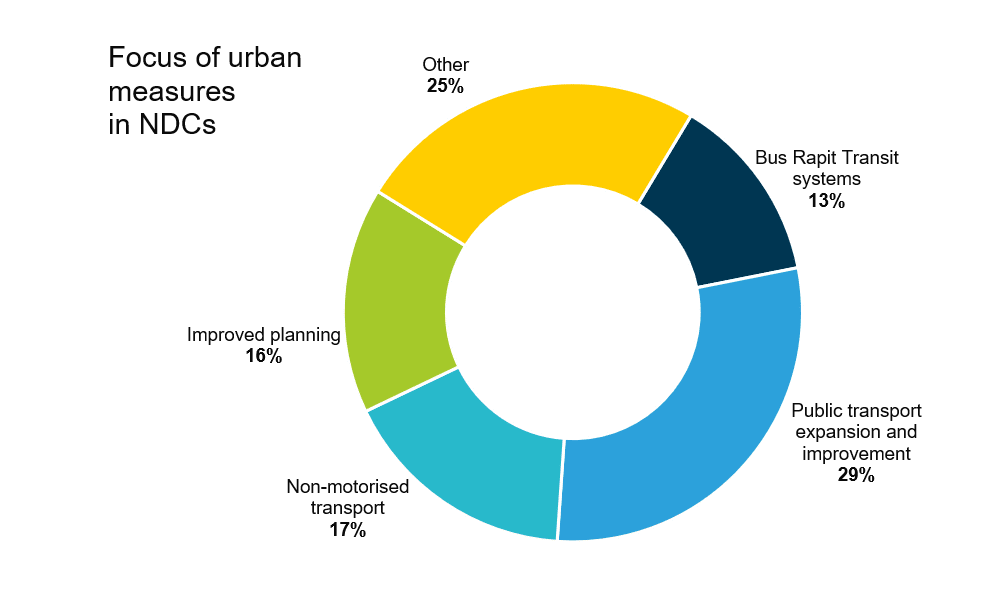
Author: Marion Vieweg
In 2020, more than half of the population on the planet (56%) were living in urban areas, and this trend towards urbanisation is set to continue. By 2050, 68% of the population is expected to live in cities. Already today, urban transport is responsible for a major share of greenhouse gas (GHG) emissions and cities’ projected growth could lead to a steep rise of transport emissions over the next decades.
This puts cities at the forefront of climate action, as it is where many measures required for decarbonisation in the sector need to be implemented.
At the same time, cities are struggling with unsustainable transport systems that cause congestion, low air quality, high numbers of accidents and large inequality of access to mobility. Well-designed climate measures don’t only abate emissions but can also help to alleviate these challenges.
As of December 2021, more than 1,000 cities had signed the Race to Zero Initiative aiming to halve global emissions by 2030 and to deliver a healthier, fairer zero carbon world. Many cities have set concrete targets and developed climate plans, some of which are considered to be 1.5°C compatible.
So far, action at city level is mostly initiated by the cities themselves, not through national frameworks that would ideally require and enable cities to mainstream climate change mitigation into transport planning. Accountability mechanisms and measurement, reporting and verification (MRV) frameworks can help identifying effective measures while also ensuring that valuable lessons are drawn from thwarted policies.
For implementation, cities operate within national legal and financial systems and need substantial support from the national level to implement measures at scale. National policymakers must actively encourage them in building sustainable transport systems and ensure that national policy frameworks do not hinder local action. This includes providing guidance for sustainable urban mobility at the national level, direct investment support from national budgets and a review of national regulation to ensure innovative local solutions can be implemented at the local level. Otherwise, local actors face budgetary and legal restraints for action.
So, let’s take a look at how transport in the urban sphere is recognized in nationally determined contributions (NDCs) and national long-term strategies (LTS). 1
Many measures included in the NDCs would have to be implemented at the urban level. 18% of mentioned measures refer directly to urban action and many more implicitly require effort in cities.
Nevertheless, analysing NDCs from a city perspective is rather disenchanting. NDC commitments are very rarely backed by information on how national governments plan to enable and support city-level action.
Measures aiming at improving non-motorised transport infrastructure or expanding public transport services, such as the installation of bus rapid transit systems for example, require substantial investments. Those investment-heavy measures make up almost 60% of those directly linked to urban mobility systems. However, only very few NDCs provide any indication about potential sources of funding for such investments.

Some funding will need to come from international support, especially funding for low-income countries. At the national and urban level, funding could be made available by re-directing financial flows from unsustainable investments, such as fossil fuel subsidies, to more sustainable assets. Other economic instruments, such as vehicle taxes, road pricing and fuel taxes can also provide sources of funding. Despite the clear need for such funding measures, only around 4% of measures in NDCs describe existing or planned use of such instruments.
NDCs also mention improved planning from cities, which is, in fact, crucial for sustainable urban mobility systems. Some reference to urban development plans for individual cities, urban mobility plans in general, or the need for integrated urban planning. Concrete support can be provided through National Urban Mobility Plans, which include target setting and investment plans, as outlined above, as well as contextual policy interventions and technical support. The latter is essential to back city officials that might lack experience in mainstreaming climate change in city and transport planning.
| Box: Providing guidance at the national level Through the EU financed EUROCLIMA+ programme and in cooperation with the Chilean national government, GIZ supported the development of a National Urban Mobility Programme (NUMP) for Chile, which serves as a general enabling framework for urban mobility planning efforts by cities and regions. It provides technical guidance on a wide range of technical issues relevant for the transport sector. The NUMP is accompanied by the country’s national strategy on sustainable mobility which is available here. |
In many countries, national policy frameworks restrict cities in their decision-making, which then hampers the testing and implementation of novel ideas and concepts. A lack of decision-making power at the local level, for example, hinders changes in the local transport system, for example for vehicle taxation, introduction of speed limits or zoning for transit-oriented development. National regulations sometimes also hamper enhanced private sector involvement when they don’t allow for the testing of new business models, e.g., for the provision of electric charging infrastructure, that may be impeded by inflexible electricity pricing regulation.
Funding for concrete investments and national-level guidance are important, but it is equally essential to create supporting policy frameworks that enable cities to be innovative and find solutions that work in their specific local context. We currently see very little on this in NDCs, despite the fact that most NDCs include long lists of transport measures.
This blog article is part of a series of five blog articles around transport in new and updated NDCs and LTS based on an assessment by GIZ and SLOCAT and funded by the International Climate Initiative (IKI) of the German Federal Ministry for the Environment, Nature Conservation, Nuclear Safety and Consumer Protection. For a comprehensive overview of further aspects of the assessment take a look at our brochure. The blog series follows recommendations for policymakers on how to enhance climate ambition in transport (available here).
Check out other blog articles of the series and stay tuned for more articles to come!
Published 11.01.2022
[1] This analysis covers all updated NDCs and second NDCs submitted up to 25 November 2021 ↩
